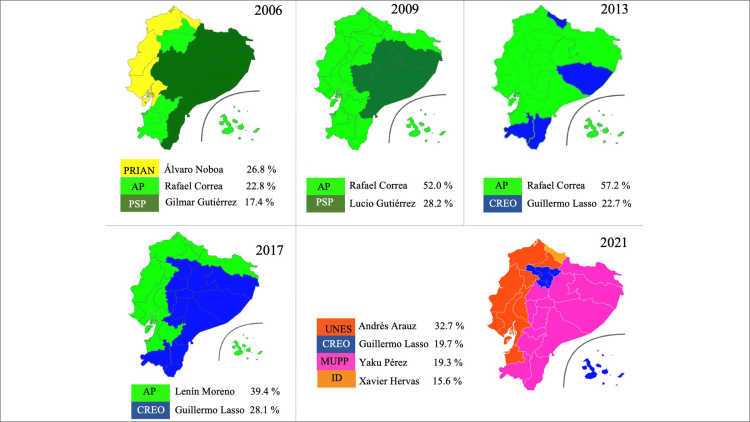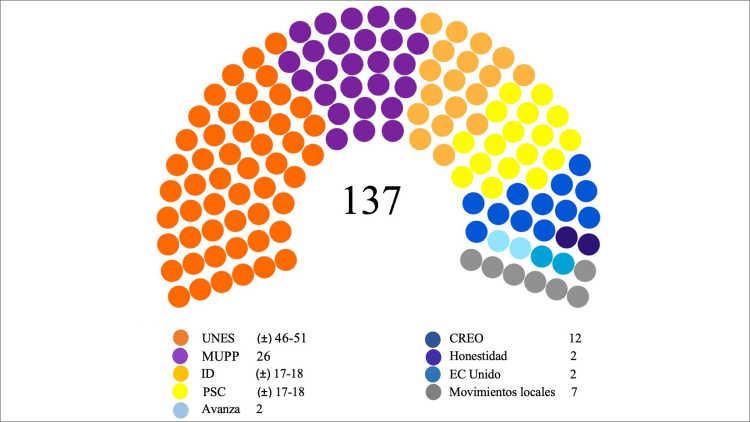- Startseite
- Publikationen
- GIGA Focus
- Elections in Ecuador: An Emerging Alternative beyond the Left–Right Antagonism
GIGA Focus Lateinamerika
Wahlen in Ecuador: Eine Alternative jenseits des Rechts-Links-Antagonismus entsteht
Nummer 2 | 2021 | ISSN: 1862-3573

Bei den Präsidentschaftswahlen in Ecuador kommt es am 11. April 2021 zu einer Stichwahl zwischen dem linken Kandidaten Andrés Arauz der UNES-Koalition und dem rechtskonservativen Guillermo Lasso von der Allianz PSC–CREO. Auch wenn dies eine konventionelle Links-Rechts-Auseinandersetzung zu sein scheint, überraschten im ersten Wahlgang die guten Ergebnisse von Yaku Pérez von Pachakutik und Xavier Hervas von ID.
In Ecuadors Stichwahl stehen zwei gegensätzliche Entwicklungsmodelle zur Wahl. Arauz will die anti-neoliberale „Bürgerrevolution“ des Expräsidenten Rafael Correa fortsetzen, während Lasso die alte neoliberale Agenda vertritt. Beide setzen zur Finanzierung ihrer Entwicklungspläne auf die Einkünfte aus dem Extraktivismus.
In der ersten Runde vermieden Arauz und Lasso es, sich bei den Themen Umwelt, Geschlecht und sexuelle Minderheiten zu positionieren. Für die zweite Runde haben beide in Anerkennung der Erfolge der alternativen Entwürfe von Pachukatik und der Demokratischen Linken (ID) ihre Agenda ergrünen lassen und sich als „Frauen und LTGBI-freundlich“ präsentiert.
Trotz einer linken Mehrheit im Parlament, bleibt die Bildung einer geeinten linken Front Wunschdenken. Die Unterschiede zwischen der Unión por la Esperanza (UNES) und Pachakutik sind unüberbrückbar: erstere scheint unfähig zu sein, sich von ihrem Gründungsvater Correa abzuwenden, während die indigene Bewegung dagegen intern fragmentiert bleibt.
Beide Kandidaten der Stichwahl erhielten in der ersten Runde zusammen nur knapp etwas mehr als die Hälfte der Stimmen und kämpfen deshalb um die Unterstützung der unterlegenen Kandidaten. Pachakutik und ID haben aber angekündigt, eine Wahlempfehlung weder für Arauz noch Lasso auszusprechen. Die politische Geschichte Ecuadors zeigt, dass Stimmen nicht einfach transferiert werden können, weil die Wählerinnen und Wähler wenig programmatische oder ideologische Bindung aufweisen.
Fazit
Wer auch immer die Stichwahl gewinnt, wird sich zu den tief greifenden sozio-ökonomischen Krisen verhalten müssen, die durch die COVID-19-Pandemie verschärft werden. Trotz dieses schwierigen Umfelds werden die in der ersten Runde sichtbar gewordenen Kräfte ihre Forderungen in der Umwelt- und Sozialpolitik weiter vorantreiben. Ecuador könnte für die gesamte Region ein Beispiel für wachsenden Widerstand und politische Mobilisierungsfähigkeit werden.
Ecuador Elections: Shifting Politics
Ecuador’s elections on 7 February 2021 marked the beginning of a busy electoral year across Latin America. Amid an economic recession exacerbated by the COVID-19 outbreak, what is at stake in this electoral race is the comeback of the “progressive left” – as occurred in Argentina in 2019 and Bolivia in 2020 – or the continuity of the neoliberal programme, a model still prominent in the region.
The Ecuadorian elections have surprised many observers this year: While Arauz mobilized his base and made it to the run-off with a strong 32.72 per cent of the vote, for two weeks right-wing candidate Guillermo Lasso and environmental activist Yaku Pérez were nearly tied for second place. Eventually, Lasso was declared ahead by a mere 0.35 percentage points (having won 19.74 per cent, versus 19.39 for Pérez). A second surprise was the remarkable performance of Xavier Hervas from the Izquierda Democrática (Democratic Left, ID), who obtained 15.68 per cent of the vote. The remaining 12 contenders combined won 10 per cent of the vote.
The two-week battle for second place raised concerns over the fairness of the electoral process. Yaku Pérez alleged fraud and formally submitted a request to the electoral authorities for a recount of approximately six million ballots in 17 of the country’s 24 provinces. The National Electoral Council (Consejo Nacional Electoral, CNE) denied these petitions. The ID also rejected the lack of transparency in the electoral process and criticized the CNE’s decision not to examine the computing system.
Contemporary politics in the Andean country have rested on simplistic dichotomies: socialism versus neoliberalism, left versus right, progressive left versus radical left, and Correísmo versus Anticorreísmo. These cleavages also exist particularly in those South American countries where pink tide governments have ruled. In Ecuador, Correísmo versus Anticorreísmo revolves around the figure of former president Rafael Correa, who left office in 2017 still enjoying 60 per cent of popular support – after his subsequent conviction for corruption, he was barred from participating in this presidential election. Correa used his significant influence to handpick the now outgoing president Lenín Moreno in 2017, and chose Arauz to stand for the presidency in 2021.
Even if, at first glance, the apparent left–right cleavage seems to have prevailed in the current Ecuadorian elections, the results could be read as society demanding a new generation of politicians, narratives, and debates that transcend the polarizing dichotomies. Approximately 35 per cent of the voters turned to two candidates who represented alternatives to the traditional cleavage. This third path was represented most prominently by Pérez from Pachakutik and Hervas from the ID. The former brought an ecological, indigenous, and anti-extractivist leftist positioning into the electoral arena. The latter shook the ID out of its inertia – even though controversies surrounding his candidature persist, such as the fact that he is a businessman and debutant politician who only recently joined the party.
This third force was obscured and countered under Correísmo (2007–2017). During this period, the indigenous movement notoriously lost its political influence, even though both the government and Pachakutik professed a leftist agenda. The explanation lies in the antagonism between two lefts: the “left in resistance” that seeks self-determination from below and autonomy from the state, and the “left in power” that promotes statist and modernizing development with social distribution (Riofrancos 2020). The differences between these two irreconcilable lefts became more evident as the years went by and centred around contentious issues such as extractivism, environmental protection, mining, and women’s and indigenous peoples’ rights.
The indigenous leader Yaku Pérez was precisely among the many leaders of that “left in resistance” that opposed Correísmo’s “left in power.” With a long trajectory of activism protecting water and opposing mining, he led popular resistance efforts in both spheres: from below in the streets, and as a subnational authority after he was elected prefect of the province of Azuay in 2019. Correa’s government fiercely opposed demands to stop the expansion of extractivism. Instead of embracing these popular claims for the construction of a solid leftist bloc, the government responded through persecution and accusations of terrorism and sabotage. Any criticism of the government’s leftist agenda coming from other lefts was dismissed as representing a minority perspective or, worse, as being associated with conservative right-wing attempts to put an end to the “Citizen Revolution.” Correísmo left no political space for alternatives, even if they surged from a deeply popular left. Ecuador was not alone in this experience, as similar dynamics also – to varying extents – marked other progressive-led South American governments, such as those of Bolivia, Argentina, Venezuela, and Brazil.
Over the years, Ecuador has shown that the real struggles for power are in the streets. Right after outgoing president Moreno won the 2017 elections, he abandoned the electoral promises he had proclaimed under the banner of Correísmo and gradually implemented austerity and privatization policies as part of structural agreements with the International Monetary Fund (IMF). He faced a massive uprising in October 2019 that was led by the indigenous movements and supported by large sectors of society. These were early signs that a third force was starting to configure itself and become visible. The return of the indigenous movement to the streets after years of being displaced and its electoral victory in the 2021 elections is a milestone in Ecuadorian politics.
Breaks in the Political Establishment
The reconfiguration of the political panorama poses challenges to all actors within the Ecuadorian establishment and confronts them with their own weaknesses. The first-round election results are a bittersweet victory for the Correísta left, represented by Arauz; a clear warning for the conservative right; and a remarkable success for the alternative lefts. This becomes even more apparent when we compare the performance of these actors in the presidential elections of the last 15 years (Figure 1 below).
Even though Arauz came in first in the February elections, his 32.7 per cent fell far short of the overwhelming support Correísmo enjoyed in the past. In fact, after five years in government, Rafael Correa still won the 2013 presidential elections in a landslide, with 57 per cent of the vote in the first round, eliminating the need for a second round. However, the data show that his political capital has been declining: compared to 2013, the share of first-round votes for the Correísmo candidate had dropped by 17.8 per cent in 2017 and by 24.5 per cent in 2021. The effect of Correa’s endorsement of Arauz – the 36-year-old technocrat previously unknown in the political realm – remains to be seen.

For Lasso and his alliance, the electoral results are a warning call, as the Partido Social Cristiano – Creando Oportunidades (Social Christian Party – Creating Opportunities, PSC–CREO) conservative coalition simply did not bear enough fruit. In this year’s race for the presidency, Lasso obtained eight percentage points fewer than he did in 2017. Geographically speaking, he won in only two provinces: Pichincha, which includes the capital, Quito, and among the 25,000 inhabitants of the Galápagos Islands; while in 2017, he won in most of the Amazon and highland regions. One of the biggest reversals for the PSC has been its defeat in the province of Guayas on the Pacific coast, its traditional bastion for 30 years. The mishandling of the COVID-19 pandemic in this PSC-led province took its toll, tarnishing Lasso’s image. Considering that this is Lasso’s third time standing in presidential elections, if he does not win the run-off, it might be the end of his political career.
The electoral contest reveals a remarkable success for the “alternative lefts.” Yaku Pérez from Pachakutik – the indigenist and environmentalist left – was practically tied for second place, until the final count saw him lose to Lasso by 32,000 votes. In addition, Xavier Hervas revived the ID after years of irrelevance in the political arena, achieving the party’s best result since 1988. Pérez’s success is also reflected in the results of the referendum – which took place in parallel to the elections – on large-scale and medium-scale metal mining in Ecuador’s third-largest city, Cuenca, located in Azuay. More than 80 per cent of the population said “no” to mining in areas close to hydrographic zones. This result reaffirms local support for Pérez’s anti-mining advocacy during his time as the prefect of Azuay.
Although Pachakutik did not make it to the second round of the presidential race, it consolidated itself as a possible alternative to the antagonist models that have polarized Ecuador’s contemporary politics. This is borne out by the victory that the movement obtained in the National Assembly, where the biggest three parties represent different lefts: Unión por la Esperanza (Union for Hope, UNES), which obtained between 46 and 51 seats, Pachakutik 26, and the ID 17 to 18. The two right-wing forces CREO and the PSC won 12 seats and 17 to 18 seats, respectively. For Pachakutik, these are the best results in the legislature in its 25 years of existence (Figure 2).

In spite of the left majority in the National Assembly, the consolidation of a unified leftist front is wishful thinking. The differences between the Correísmo “progressive left” and the indigenous movement are irreconcilable. Internal frictions within each leftist force also pose a challenge. One faction of Correísmo supporters seems incapable of turning away from its omnipresent leader, Correa, while another is open to renovation and new figures. In the case of the ID, there are tensions between Hervas and the ID as a party, as he became an official member of the ID only after the first round. He himself announced his support for the right-wing candidate Lasso in the run-off, while his party made an official statement not supporting any of the candidates. It is not clear how the ID will position itself after years of absence in Ecuadorian politics.
The indigenous movement has its own ideological divisions, with some factions more radical than others. Jaime Vargas and Leonidas Iza, the leading figures of the October 2019 uprisings and of the Confederation of Indigenous Nationalities of Ecuador (Confederación de Nacionalidades Indígenas del Ecuador, CONAIE), initially opposed Pérez’s candidacy. Many criticize Pérez’s positions as ambiguous and even doubt whether he is really committed to a leftist anti-neoliberal agenda. Essentially, it seems he favours advancing institutional recognition of ethnic diversity and of indigenous peoples’ rights over advocating radical socio-economic structural changes that challenge neoliberalism, such as land reform and redistribution of wealth. Of course, these strategies are not mutually exclusive and could work in tandem, but not all leaders of the indigenous movement are convinced of that. Despite these tensions, the force of the movement as a whole gained much momentum.
The new political cartography after the first round of elections also confirms the return of the traditional cleavage between coast and highlands in Ecuadorian politics. Until 2009, the “progressive left” represented by Arauz was the majoritarian force in most of Ecuador; however, in 2017 it experienced setbacks in the Amazon region, and in 2021 it also lost seats in the highlands. Their votes are now concentrated in their coastal bastions.
Antagonistic Development Models and Electoral Programmes
The two candidates represent antagonistic development models. In the campaign, playing on COVID-19 metaphors, Arauz presented his programme as attacking the “virus of neoliberalism” through the “Union for Hope vaccine.” Beyond the discursive rhetoric, Correa’s “Citizen Revolution,” according to some critics, has been a project based on pure neoliberal government policy (Sierra 2011). Arauz, chosen by Correa to give continuity to his project, not only considers himself a Correísta but also the next saviour of the country, one who will vindicate the Constitution drafted by the Constituent Assembly of 2008. The new Constitution is broad in guaranteeing social rights, but it was reformed during Correa’s presidency to grant more power to the executive vis-à-vis the judicial branch (Ortiz 2020: 241–242). If elected, Arauz would give continuity to a hyper-presidential system tailor-made for the executive, following the same authoritarian line Correa walked during his 10-year tenure.
For followers of Correa and Arauz, these elections represent a historic opportunity to recover the nation and to return to the golden age of the “Citizen Revolution.” For them, Lenín Moreno embodies the figure of the “policy switcher”: a politician who promised not to implement drastic market reforms and to give continuity to the leftist project, but who betrayed the project in the end. Lasso, for his part, seeks to distance himself from his past as superminister of economy during Ecuador’s financial crisis of 1999 – referred to in Correísmo terms as the “long and sad neoliberal night.” However, his government plans do not go beyond the old neoliberal agenda, which proposes a free-market economy and a minimum state that, according to Lasso, should guarantee basic services such as education, housing, health, security, and justice. All other issues will be left in the hands of the private sector.
Regarding the economic agenda, Arauz and Lasso agree on maintaining and strengthening dollarization; however, major disagreements arise regarding their positions on the role of multilateral finance, mainly the IMF. Lasso has stated that he will respect and give continuity to the austerity agreement signed with the IMF during the Moreno government, except for the VAT increase. Lasso’s plan would be tailored to the creditors and economic groups that he represents. On the other side, Arauz has said that while he appreciates the support of the multilateral organism, he proposes a debt audit. He also warned the World Bank and other creditors that they cannot count on a total subjugation of his government to the agreements signed by the Moreno administration.
Lasso has not modernized his rhetoric in the seven years that he has been standing as a presidential candidate. In essence, he is relying on the same platform on which he lost in 2013 against Correa and in 2017 against Moreno. In the context of the COVID-19 pandemic and with corruption scandals associated with the delivery of “VIP vaccines” to elites, it is Arauz who can capitalize on the bad decisions of the current government – because the people associate Lasso with the Ecuadorian elite.
Another political battlefield is in the dimensions of environment, gender, and sexual minorities. During the first round, both candidates avoided sensitive topics such as abortion, gendered violence, and environmental protection. In an opportunistic attempt to gain votes in the second round, Arauz and Lasso lukewarmly incorporated issues on gender and sexual minorities into their agendas. Lasso approached the LGBTI community by turning to TikTok – for which he changed his look in an almost cartoonish way – to attract the attention of the younger electorate. However, his position on these matters basically corresponds to his religious beliefs: he opposes abortion and is in favour of the “traditional family.” Arauz has not spoken directly on these issues. It was expected that during the second television debate called by the CNE on 21 March, the candidates would clarify their positions, but these problematics were not even mentioned. Issues such as extractivism, insecurity and crime, femicide, and abortion continue to be left in the shadows.
On extractivism, Arauz and Lasso have both been in favour of expanding the mining and oil frontiers. For Arauz, the exploitation of the Ishpingo, Tambacocha, and Tiputini oil fields (Yasuní-ITT), along with the large-scale mining initiated by the Correa government with the Mirador and Fruta del Norte projects, are strong precedents for the continuation of extractivism (Vallejo, Cielo and García 2019). Similarly, Lasso insists that Ecuador cannot afford to keep oil and other resources underground.
Ecuador’s Road Ahead
A victory for Lasso in the run-off seems unlikely. Although the race is far from decided, the latest surveys following the presidential debate showed voters’ preference for Arauz. Given that Ecuadorians overall favoured alternatives to the final contenders, null and blank votes are expected to increase.
Both contenders are distancing themselves as much as possible from Moreno’s weakened administration. Indeed, each has good reason to do so: Arauz because Moreno had been elected as Correa’s chosen candidate in 2017, and Lasso because of his ideological sympathy with the austerity measures adopted under Moreno. As an Arauz victory becomes likely, the question arises of whether he will be capable of leading the government in an autonomous way considering the rights and wrongs of the past “progressive left.” Will he become a puppet of omnipresent leader Correa? Or will he be a “policy switcher,” as Moreno has been?
It is foreseeable that the main forces of the political establishment will modify their strategies in view of the reconfiguration of the political map. Correísmo will go through a renovation, one perhaps even led by Arauz himself as a young figure in the movement. In the face of the right-wing setback in the legislature, the PSC and CREO might also try to devise new strategies to recover their positions, becoming even more neoliberal and conservative.
Key to the success of the new president and his political movement will be the ability to build coalitions in the fragmented legislature in order to pass laws. Ecuador has a weak programmatic voting tradition and rather loose ideological party affiliations. This provides fertile ground for vote-buying practices, corruption, and the cooptation of movements and political parties.
The increased visibility of alternative lefts in the electoral sphere opens up the possibility of bringing topics such as extractivism, mining, a plurinational state, and gender issues to the societal and legislative debate. Popular forces will also persist in pushing the discussion of these topics from the streets. However, other short-term urgencies regarding the economic crisis and the problems derived from the COVID-19 pandemic will need to be solved first.
Implications beyond Ecuador’s Borders
Ecuador is inaugurating a year that will see at least nine elections in Latin America. It can thus be seen as a test case for the persistence of the so-called “pink tide.” If Arauz reaches the presidency, the reconfiguration of a new wave of leftist forces will be more apparent. However, it will not arrive on the same terms as the pink tide leftist governments that emerged in Latin America amid the extraordinary commodity boom of the first decade of the twenty-first century. The current international context, marked by economic recession and the rivalry between China and the United States, will not leave much room for the new president to implement radical changes or adopt confrontational political strategies with international actors.
Given the low geopolitical weight of the country, the likely triumph of Arauz in this election should not be seen as forecasting a regional comeback trend for the left; at best, the Argentina–Mexico–Bolivia–Ecuador leftist axis would be reinforced. In the current Latin American panorama, the only regional instance that would be invigorated is the Grupo Puebla – a political forum of left and center-left leaders, including former pink tide presidents Evo Morales from Bolivia, Lula Da Silva from Brazil, José Mujica from Uruguay, and Rafael Correa. Since this organization has openly supported Arauz’s candidacy, his victory would be very welcome.
The fortification of the Puebla Group would be to the detriment of the Lima Group, a multilateral body whose aim is to seek a peaceful solution to the crisis in Venezuela. Currently, the Moreno government supports the Lima Group, but in the scenario that Arauz wins, it is very likely that Ecuador would withdraw its support and advocate for solutions that respect Venezuela’s sovereignty, similar to the approach of Argentina, which exited this bloc just a few days ago.
Fußnoten
Literatur
CNE (Consejo Nacional Electoral) (2021), Resultados generales, https://resultados2021.cne.gob.ec/ (22 March 2021).
Ortiz, Richard (2020), Elecciones y democracia en Ecuador: La receta autoritaria de la Revolución Ciudadana 2007-2017, in: Allan R. Brewer-Carías (ed), Elecciones y Democracia en América Latina: El desafío autoritariopopulista América Latina: debates sobre la democracia. 80 años de Dieter Nohlen, Coloquio Iberoamericano No. 200 Instituto Max Planck de Derecho Público Comparado y Derecho Internacional, Heidelberg 11 septiembre 2019, Editorial Jurídica Venezolana International, 225–249.
Riofrancos, Thea (2020), Resource Radicals: From Petro-Nationalism to Post-Extractivism in Ecuador, Durham, NC: Duke University Press.
Sierra, Natalia (2011), Los “gobiernos progresistas” de América Latina. La avanzada del pos-neoliberalismo, Aportes Andinos Revista electrónica de derechos humanos, No. 29, July, https://repositorio.uasb.edu.ec/bitstream/10644/2800/1/RAA-29%20Natalia%20Sierra,%20Los%20gobiernos%20progresistas.pdf (20 March 2021).
Vallejo, Ivette, Cristina Cielo, and Fernando García (2019), Ethnicity, Gender, and Oil: Comparative Dynamics in the Ecuadorian Amazon, in: Latin American Perspectives, 46, 2, 182–198.
Gesamtredaktion GIGA Focus
Redaktion GIGA Focus Lateinamerika
Lektorat GIGA Focus Lateinamerika
Regionalinstitute
Forschungsschwerpunkte
Wie man diesen Artikel zitiert
Zapata, Ximena M., Sandra Zapata, und Santiago M. Zarria (2021), Wahlen in Ecuador: Eine Alternative jenseits des Rechts-Links-Antagonismus entsteht, GIGA Focus Lateinamerika, 2, Hamburg: German Institute for Global and Area Studies (GIGA), https://nbn-resolving.org/urn:nbn:de:0168-ssoar-72251-8
Impressum
Der GIGA Focus ist eine Open-Access-Publikation. Sie kann kostenfrei im Internet gelesen und heruntergeladen werden unter www.giga-hamburg.de/de/publikationen/giga-focus und darf gemäß den Bedingungen der Creative-Commons-Lizenz Attribution-No Derivative Works 3.0 frei vervielfältigt, verbreitet und öffentlich zugänglich gemacht werden. Dies umfasst insbesondere: korrekte Angabe der Erstveröffentlichung als GIGA Focus, keine Bearbeitung oder Kürzung.
Das German Institute for Global and Area Studies (GIGA) – Leibniz-Institut für Globale und Regionale Studien in Hamburg gibt Focus-Reihen zu Afrika, Asien, Lateinamerika, Nahost und zu globalen Fragen heraus. Der GIGA Focus wird vom GIGA redaktionell gestaltet. Die vertretenen Auffassungen stellen die der Autorinnen und Autoren und nicht unbedingt die des Instituts dar. Die Verfassenden sind für den Inhalt ihrer Beiträge verantwortlich. Irrtümer und Auslassungen bleiben vorbehalten. Das GIGA und die Autorinnen und Autoren haften nicht für Richtigkeit und Vollständigkeit oder für Konsequenzen, die sich aus der Nutzung der bereitgestellten Informationen ergeben.













